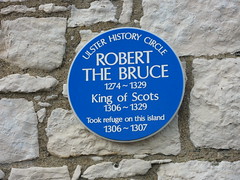King Robert the Bruce
Commemorated on 7 plaques
Robert the Bruce 1274-1329 King of Scots 1306-1329 took refuge on this island 1306-1307
Visitor's Centre, Rathlin Island, United Kingdom where they took refuge
This station stands on the site of the Great Hall of Berwick Castle. Here on the 17th November 1292 the claim of Robert Bruce to the Crown of Scotland was declined and the decision in favour John Baliol was given by King Edward I before the full Parliament of England and a large gathering of the nobility and populace of both England and Scotland.
Berwick-upon-Tweed railway station, Railway Street, Berwick-upon-Tweed, United Kingdom where they was (1291)
Clatteringshaws Dam. Constructed by The Galloway Water Power Company 1932-34 Clatteringshaws Dam and the loch occupy ground memorable in Scottish history; close by the dam ran the old Edinburgh road leading to Whithorn (Candida casa IV-V th century). The earliest Christian foundation in Scotland. The waters of the loch are gathered from the fastnesses of the dungeon of Buchan and from the site of that ancient forest of Buchan where Robert Bruce was hard pressed by his enemies after his return to Scotland from Rathlin in 1307. A victory gained near this place by Robert Bruce or his brother Edward is commemorated by the great boulder known as the King's or Bruce's Stone which stands near the shores of the loch 700 yards north of Clatteringshaws Farm. Mary Queen of Scots passed this way on 13th August 1563. The surrounding wilds were sought as a refuge by the covenanters during their struggles in the seventeenth century.
Clatteringshaws Dam, Galloway Forest Park, United Kingdom where they was (1306)
"For God and St. Andrew" Robert The Bruce King of Scots planted his standard near this spot when the Scottish patriots under his command vanquished the army of Edward II of England at the Battle of Bannockburn 24th June 1314 "We fight not for glory nor for wealth, nor honour but only and alone we fight for freedom which no good man surrenders but with his life"
in the grounds of Bannockburn Heritage Centre, FK7 0LJ, Stirling, United Kingdom where they planted his standard near this spot (1313)
Dunblane Bridge The first bridge across the river at Dunblane was built about 1410. Previously, the river was forded fifty yards upstream from here. This was an important river crossing on the main road north from Stirling. The ford was used by the armies of Wallace and Bruce before the Battles of Stirling Bridge and Bannockburn in 1297 and 1314.
Millrow, Dunblane, United Kingdom where they was
ROBERTUS DEI GRATIA REX SCOTORUM This plaque was placed here to commemorate the sepulture here within the ruined bounds of Saint Serf's Parish Church, Little Kirkton, of the embalmed viscera from the body of King Robert 'The Bruce' on or about the third week of June 1329. The dying monarch requested that his heart be taken to Jerusalem by a Knight Templar in fulfilment of a sacred vow he had made earlier in his reign to go on a crusade to the Holy Land in Palestine. On the same day and at the hour appointed for the entombment of the King in Dunfermline Abbey, a simultaneous service of sepulture was conducted within the precincts of this venerable edifice.
, Dumbarton, United Kingdom where they lay in state
Bruces Well, known to have been in existance since the 13th century serving the needs of the community attached to the Spittal and Lazarr House bearby and adjacent to the church of St. Ninian. King Robert the 1st of Scotland (the Bruce) benefitted from the water of the well and generously endowed the Lazard House. Erected by the Kyle & Carrick District Council
Maryborough Road, Prestwick, United Kingdom where they benefitted from from the waters of the well








